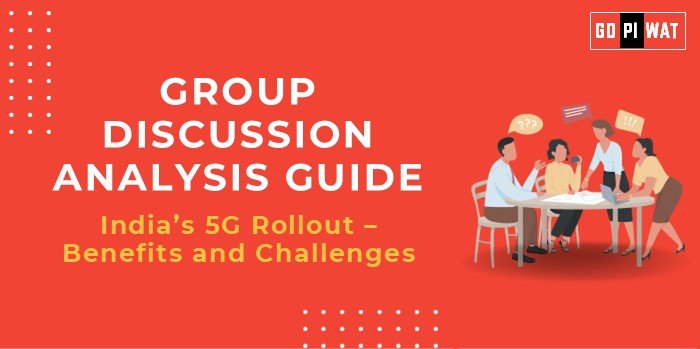📋 Group Discussion (GD) Analysis Guide: India’s 5G Rollout – Benefits and Challenges
🌐 Introduction to India’s 5G Rollout
- Opening Context: India’s 5G rollout marks a pivotal advancement in the nation’s digital transformation, promising to revolutionize connectivity, drive economic growth, and foster innovation across various sectors.
- Topic Background: Initiated in October 2022, India’s 5G deployment aims to enhance network capabilities, support emerging technologies, and bridge the digital divide. As one of the world’s largest telecom markets, India’s approach to 5G will significantly influence its technological and economic trajectory.
📊 Quick Facts and Key Statistics
- 🗓️ Launch Date: October 1, 2022
- 📈 Coverage Milestone: By August 2023, India ranked 47th globally in mobile network speed, a leap from 119th position in September 2022, reflecting the impact of 5G deployment.
- 💰 Economic Impact: 5G is projected to contribute ₹36.4 trillion (approximately $455 billion) to India’s economy between 2023 and 2040, accounting for over 0.6% of GDP by 2040.
- ⚖️ Spectrum Auction: In 2022, India conducted its largest spectrum auction, allocating 51,236 MHz (71% of the total) with bids amounting to ₹1,50,173 crore.
- 📶 Subscriber Growth: 5G subscriptions in India are expected to reach 130 million by the end of 2023.
🏢 Stakeholders and Their Roles
- Government: Policy formulation, spectrum allocation, and infrastructure development support.
- Telecom Operators: Deployment of 5G infrastructure, service provision, and innovation in applications.
- Consumers: Adoption of 5G services, driving demand for enhanced connectivity and applications.
- Technology Providers: Supplying equipment, devices, and technological solutions to enable 5G services.
- Regulatory Bodies: Ensuring compliance, managing spectrum, and facilitating a conducive environment for 5G growth.
🏆 Achievements and Challenges
🎉 Achievements
- ⚡ Rapid Deployment: Within nine months of launch, India deployed approximately 2.7 lakh 5G sites, marking one of the fastest rollouts globally.
- 📈 Enhanced Network Performance: Median download speeds increased from 13.87 Mbps in September 2022 to 50.21 Mbps in August 2023, a 3.59-fold improvement.
- 📊 Economic Prospects: 5G is anticipated to significantly boost sectors like healthcare, education, and manufacturing through advanced applications and services.
⚠️ Challenges
- 🏗️ Infrastructure Development: High costs and logistical challenges in deploying 5G infrastructure, especially in rural areas.
- 💸 Spectrum Pricing: Expensive spectrum auctions strain telecom operators’ finances, potentially impacting service affordability.
- 📱 Device Compatibility: Limited penetration of 5G-compatible devices among consumers may slow adoption rates.
🌍 Global Comparisons
Countries like South Korea and China have achieved extensive 5G coverage and high adoption rates, serving as benchmarks for India’s rollout.
🏙️ Case Studies
In Kerala, the state government has initiated projects leveraging 5G for smart city developments, enhancing public services and infrastructure management.
💬 Structured Arguments for Discussion
- Supporting Stance: “India’s swift 5G rollout is a testament to its commitment to digital advancement, promising substantial economic growth and technological innovation.”
- Opposing Stance: “Despite rapid deployment, India’s 5G rollout faces significant hurdles, including high infrastructure costs and limited rural reach, which may impede its overall success.”
- Balanced Perspective: “While India’s 5G rollout demonstrates impressive progress, addressing challenges like infrastructure costs and equitable access is crucial for realizing its full potential.”
📚 Effective Discussion Approaches
- Opening Approaches:
- 📊 Statistical Highlight: “India’s median mobile download speed surged from 13.87 Mbps to 50.21 Mbps within a year of 5G deployment, showcasing the technology’s impact.”
- 💸 Economic Emphasis: “With 5G expected to contribute ₹36.4 trillion to the economy by 2040, its rollout is pivotal for India’s future growth.”
- Counter-Argument Handling: Acknowledge challenges such as high deployment costs and propose solutions like public-private partnerships and phased rollouts to mitigate these issues.
📈 Strategic Analysis of Strengths and Weaknesses
🌟 Strengths
- ⚡ Rapid deployment capabilities.
- 🛡️ Strong government support and policy initiatives.
- 📊 Large consumer base eager for advanced connectivity.
📉 Weaknesses
- 💸 High infrastructure and spectrum costs.
- 🌍 Digital divide between urban and rural areas.
- 📱 Limited availability of 5G-compatible devices.
🌐 Opportunities
- 🏙️ Development of smart cities and IoT applications.
- 📈 Enhancement of sectors like healthcare, education, and agriculture through 5G technologies.
- 🚀 Potential to become a global leader in 5G innovation and applications.
⚠️ Threats
- 🔒 Cybersecurity risks associated with advanced connectivity.
- 💰 Economic constraints affecting investment in infrastructure.
- 🌍 Competition from other countries advancing rapidly in 5G technology.
🎓 Connecting with B-School Applications
- Real-World Applications: Exploring business models leveraging 5G for innovation in sectors like finance, healthcare, and logistics.
- Sample Interview Questions:
- ❓ “How can businesses capitalize on India’s 5G rollout to enhance productivity and innovation?”
- ❓ “What measures should the government take to ensure equitable access to 5G across rural and urban areas?”
- Insights for B-School Students:
- 🏛️ Role of Policy: Deep understanding of regulatory dynamics in shaping market opportunities.
- 📈 Strategic Project Planning: Leveraging 5G to drive business transformations and improve operational efficiencies.
- 💡 Technology-Driven Innovation: Exploring how 5G technology reshapes consumer behavior, competitive strategies, and product development in various sectors.


